Is your little one on the verge of crawling and exploring into places at home that they shouldn’t? Are you starting to wish that you had superhuman powers, to protect them from harm and be in every room at once? It’s time to become a Home Safety Super-Parent!
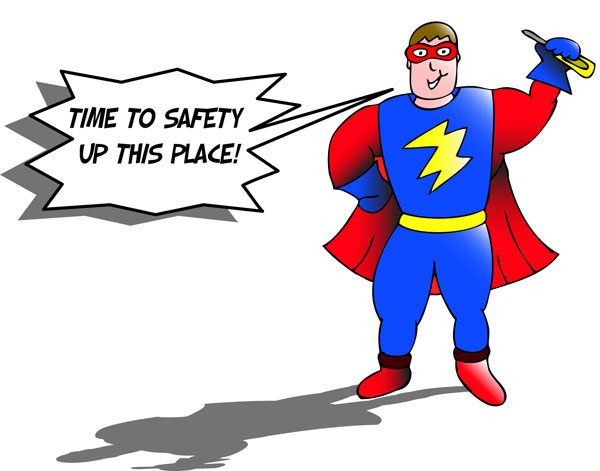
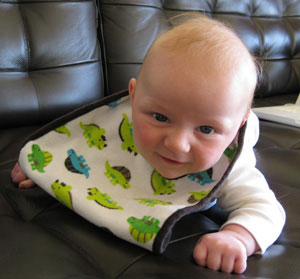 Safety proofing your home for an increasingly active baby is a must, but something that new parents often dread. “I don’t know where to start!” “There’s so many gadgets that we need!” It can be overwhelming knowing how to start safety proofing your home for baby, but luckily you do not have to wrap your whole home in bubble wrap (phew!) In a few simple steps you can easily make your home safe for your mobile baby and feel like a Super-Parent! (Well, at least until you leave the house anyway!)
Safety proofing your home for an increasingly active baby is a must, but something that new parents often dread. “I don’t know where to start!” “There’s so many gadgets that we need!” It can be overwhelming knowing how to start safety proofing your home for baby, but luckily you do not have to wrap your whole home in bubble wrap (phew!) In a few simple steps you can easily make your home safe for your mobile baby and feel like a Super-Parent! (Well, at least until you leave the house anyway!)
Read on to find out more!
Super Vigilance – First of all, remember however much you safety proof your home, the most important thing is to be super vigilant of your baby’s movements. Baby should not be left on their own in a room, unless they are safely in a crib or play yard – and even then only for a few minutes (unless they are asleep of course). No safety gadget is a substitute for the watchful eye of an adult. Careful scrutiny will also enable you to notice any potential dangers around the home. It will also give you the opportunity to start saying “No” to baby when she is about to stray into dangerous territory – and to offer her a safe alternative, like a toy, instead. (Note – this will need to be done repeatedly!)
Safe Zones – Although vigilance is key, even a careful parent can’t be everywhere at once, with their eyes on baby every single second! Give yourself the super power of duplicity by creating ‘safe zones’ within the home. These might be baby’s room and the lounge for example. Make sure your safe zones are fully safety proofed from top to bottom with gates, cupboard locks, window stops, electric outlet covers – whatever is necessary. Apply corner and edge bumpers to any sharp areas of furniture, to avoid any nasty knocks. Ever wish you possessed Superman’s super senses? Install a video monitor in baby’s room, so you can keep an eye and an ear on her when she is sleeping, or playing in her crib. When baby is in a safe zone you will still need to stay close by, but you can feel reassured she is safe and pop out for a second if needed. Most importantly, baby has freedom to roam!
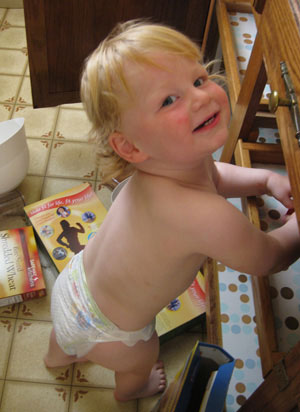 Lock dangerous items away – Prevent injuries and poisonings by creating a protective armor any superhero would be proud of – keep dangerous items like knives, cleaning items and medicines locked away in cupboards, or on shelves high out of reach. Also put a lock on the toilet if this is accessible to baby – as the toilet poses a drowning risk. We love this locking system to safety proof our cupboards, as the cupboard stays fully locked – unlike latches that can trap little fingers. Make sure your locking system is easy for an adult to use, but difficult for a child to disable! You may want to keep whole rooms off limits if they present too many dangers – the kitchen and the bathroom, for example. Do this by installing a lock on the outside of the room, or by using a door handle cover that only an adult can use. Ensure that the door can be opened quickly in case of an emergency. You might like to keep an unlocked ‘safe cupboard’ available for baby to explore. This should be low level and only contain items that are safe for baby – a sieve, some plastic bowls, cereal boxes – you get the idea!
Lock dangerous items away – Prevent injuries and poisonings by creating a protective armor any superhero would be proud of – keep dangerous items like knives, cleaning items and medicines locked away in cupboards, or on shelves high out of reach. Also put a lock on the toilet if this is accessible to baby – as the toilet poses a drowning risk. We love this locking system to safety proof our cupboards, as the cupboard stays fully locked – unlike latches that can trap little fingers. Make sure your locking system is easy for an adult to use, but difficult for a child to disable! You may want to keep whole rooms off limits if they present too many dangers – the kitchen and the bathroom, for example. Do this by installing a lock on the outside of the room, or by using a door handle cover that only an adult can use. Ensure that the door can be opened quickly in case of an emergency. You might like to keep an unlocked ‘safe cupboard’ available for baby to explore. This should be low level and only contain items that are safe for baby – a sieve, some plastic bowls, cereal boxes – you get the idea!
Secure furniture –Unstable furniture can tip over on baby when they try to climb or pull up on it, causing potential injuries or death. Create the super hero power of anti-gravity by securing any heavy or unstable furniture, such as bookcases, tv, drawer units, by anchoring to the floor, or attaching to the wall.
Cover electrical outlets – Wield the power of camouflage by keeping electrical outlets covered and hidden from baby’s prying fingers. Ensure that the covers can’t be easily removed and do not present a choking hazard. You can either use covers that plug into the sockets(especially good for outlets not in use) or those with a plate or box over the entire outlet(especially good for outlets in use). Keep electrical cords out of reach.
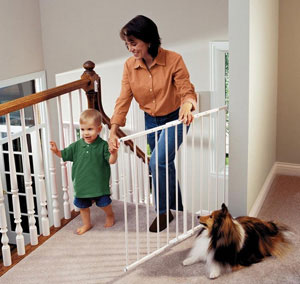 Safety Gates – Create a force field around your safe zones with safety gates. Install gates at the top and bottom of stairs as necessary and to block off any rooms or areas where you do not want baby to stray. Go for hardware mounted gates near stairways or anywhere that there is a risk of falling. Although they take a little effort to install, they are much safer than pressure mounted gates. Pressure mounted gates are fine for blocking off rooms, but check they have a bar across the top to stop little fingers becoming trapped.
Safety Gates – Create a force field around your safe zones with safety gates. Install gates at the top and bottom of stairs as necessary and to block off any rooms or areas where you do not want baby to stray. Go for hardware mounted gates near stairways or anywhere that there is a risk of falling. Although they take a little effort to install, they are much safer than pressure mounted gates. Pressure mounted gates are fine for blocking off rooms, but check they have a bar across the top to stop little fingers becoming trapped.
Window guards and coverings – Make an invisible safety shield over your windows! Use window guards or stops as necessary – limiting window openings to 4 inches or less. Ensure the guards are effective, but can also be removed quickly in case of fire. If you have double hung windows (like we do!) open windows from the top, or use window stops to prevent the windows from opening too wide. We love these window stops, as they are easy to install, effective and can be removed quickly in an emergency. For windows that need extra protection, use a window guard that covers the lower half of the window. We use this window guard in Little M’s room, as his room his small and the window is low – works brilliantly and blends into the room too! Use cordless blinds and window coverings, in order to prevent the risk of strangulation. Small children’s necks can easily become entangled in cords – even if you think they are hidden. If you already have blinds with cords – simply remove the cords!
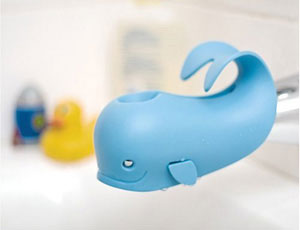 In the bath– Give yourself super heat sensors by setting your water heater to 120°F (48°C) to prevent scalding. Keep baby out of reach of the faucet and cover it with a soft cover. Place a non-skid mat inside the tub, to stop baby slipping. NEVER leave baby alone in the tub, as babies can drown in as little as an inch of water.
In the bath– Give yourself super heat sensors by setting your water heater to 120°F (48°C) to prevent scalding. Keep baby out of reach of the faucet and cover it with a soft cover. Place a non-skid mat inside the tub, to stop baby slipping. NEVER leave baby alone in the tub, as babies can drown in as little as an inch of water.
Smoke alarms and Carbon Monoxide Detectors– Smoke alarms are essential safety devices to protect against deaths and injuries from fires. Install smoke alarms on every level of your home, inside each bedroom and outside sleeping areas. Also add carbon monoxide detectors near sleeping areas. Check smoke alarms once a month to make sure they’re working and change batteries in all alarms at least once a year. Consider installing a simple and affordable home security system, like this one from dropcam – with cameras in areas of the home that you want to keep an extra eye on. Now you really can have super senses!
Emergency information – Make sure you’ll have the durability of a superhero in the case of an emergency. Keep a list of key telephone numbers handy – these should include the following for your area: poison control, emergency medical services, hospital emergency room, fire department, police department, your child’s doctor, work numbers and friends/relatives to call in case of an emergency. Keep the list near the telephone and ensure it is clear to read. You could also save the numbers into your phone. Consider taking a First Aid/CPR course, so you’ll know what to do in an emergency.
Now that your home is super safe you can relax (sort of!) knowing that baby is safe to roam and explore their surroundings– just what all babies should be doing! Zoom! Pow! Just make sure to keep your eyes open for any new dangers that may present themselves though. As baby grows, new risks may arise. A Home Safety Super-Parent’s work is never (quite) done!
Any other tips on home safety to offer? How did you become a Home Safety Super-Parent?
Disclosure: This post contains some affiliate links, however all opinions are entirely my own.
[plinker]



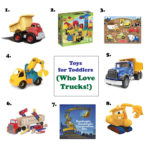







Leave a Reply